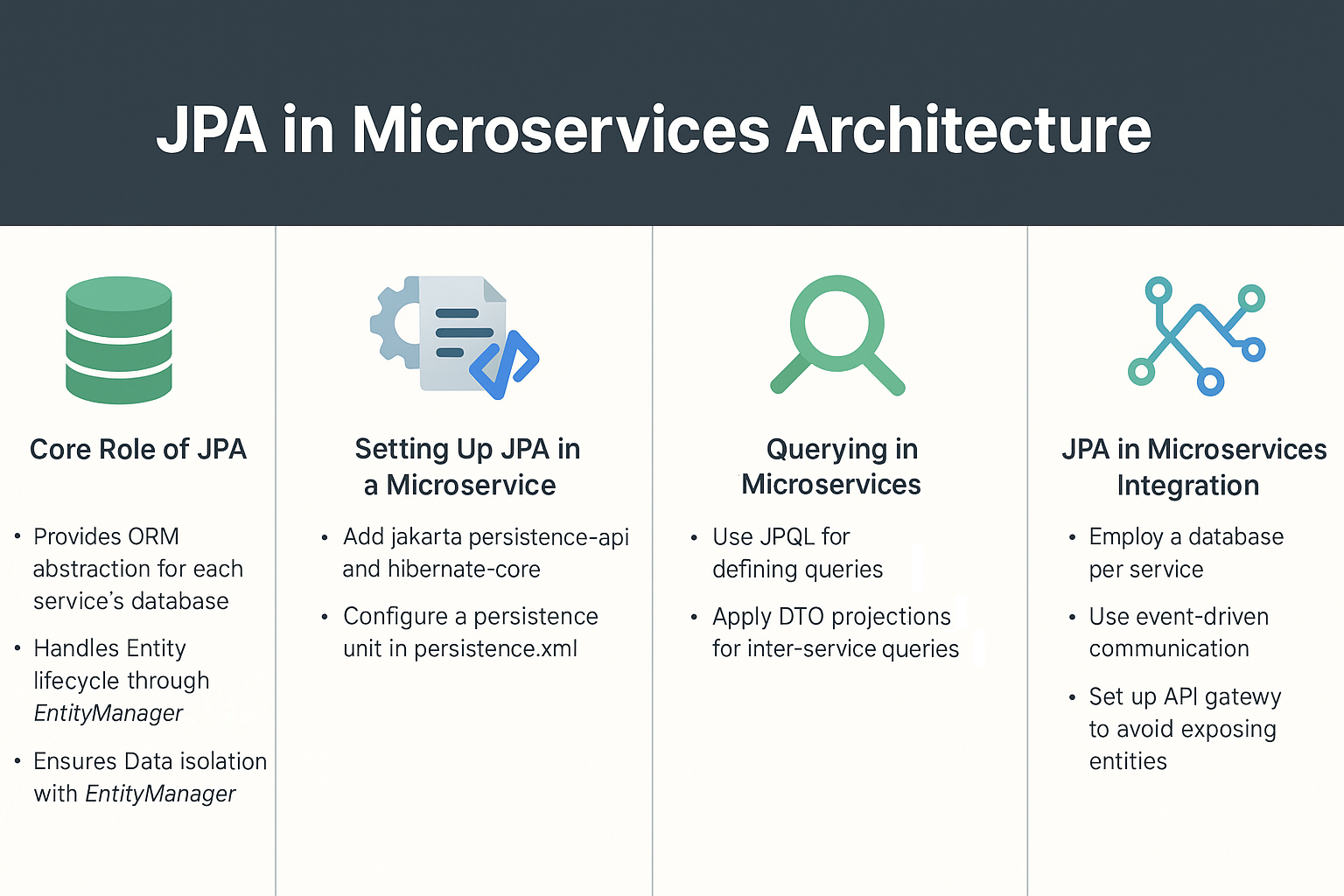Microservices architecture breaks large monolithic applications into smaller, independently deployable services. Each microservice typically owns its data and business logic. While JPA (Jakarta Persistence API) simplifies database access, using it in microservices requires special attention to scalability, data isolation, and performance.
Think of microservices as independent restaurants in a food court. Each restaurant has its own kitchen (database) and staff (business logic). JPA acts as the waiter who ensures that orders (queries) reach the kitchen efficiently and results are returned consistently.
Core Role of JPA in Microservices
- Provides ORM abstraction for each service’s database.
- Handles entity lifecycle management through
EntityManager. - Ensures data isolation—each microservice typically has its own schema.
- Simplifies CRUD operations, allowing developers to focus on business logic.
Setting Up JPA in a Microservice
Maven Dependencies
<dependency>
<groupId>jakarta.persistence</groupId>
<artifactId>jakarta.persistence-api</artifactId>
<version>3.0.0</version>
</dependency>
<dependency>
<groupId>org.hibernate.orm</groupId>
<artifactId>hibernate-core</artifactId>
<version>6.2.0.Final</version>
</dependency>
persistence.xml
<persistence xmlns="https://jakarta.ee/xml/ns/persistence" version="3.0">
<persistence-unit name="orderServicePU">
<provider>org.hibernate.jpa.HibernatePersistenceProvider</provider>
<properties>
<property name="jakarta.persistence.jdbc.url" value="jdbc:mysql://localhost:3306/orders"/>
<property name="jakarta.persistence.jdbc.user" value="root"/>
<property name="jakarta.persistence.jdbc.password" value="password"/>
<property name="hibernate.hbm2ddl.auto" value="update"/>
<property name="hibernate.show_sql" value="true"/>
</properties>
</persistence-unit>
</persistence>
Example Entity and CRUD Operations
import jakarta.persistence.*;
@Entity
@Table(name = "orders")
public class Order {
@Id
@GeneratedValue(strategy = GenerationType.IDENTITY)
private Long id;
private String customer;
private double amount;
// Getters and Setters
}
CRUD with EntityManager
@Stateless
public class OrderService {
@PersistenceContext
private EntityManager em;
public void createOrder(Order order) {
em.persist(order);
}
public Order findOrder(Long id) {
return em.find(Order.class, id);
}
public Order updateOrder(Order order) {
return em.merge(order);
}
public void deleteOrder(Long id) {
Order order = em.find(Order.class, id);
if (order != null) em.remove(order);
}
}
Querying in Microservices
JPQL
List<Order> orders = em.createQuery(
"SELECT o FROM Order o WHERE o.amount > :amount", Order.class)
.setParameter("amount", 100.0)
.getResultList();
Criteria API
CriteriaBuilder cb = em.getCriteriaBuilder();
CriteriaQuery<Order> cq = cb.createQuery(Order.class);
Root<Order> root = cq.from(Order.class);
cq.select(root).where(cb.greaterThan(root.get("amount"), 100.0));
List<Order> results = em.createQuery(cq).getResultList();
Fetching Strategies and Performance
- Use Lazy fetching for relationships to avoid unnecessary data loading.
- Apply DTO projections for inter-service communication instead of exposing entities.
- Keep queries service-specific to avoid cross-service joins.
JPA in Microservices Integration
- Database per service: Each service owns its schema.
- Event-driven communication: Use Kafka, RabbitMQ, or JMS for data sync.
- API Gateway + DTOs: Never expose entities across services; use DTOs.
- Spring Boot Integration: With
spring-boot-starter-data-jpa, configuration is simplified.
Common Pitfalls
- Shared Database Across Services: Breaks microservice independence.
- Eager Fetching: Loads unnecessary data, slowing down services.
- Direct Entity Exposure: Causes tight coupling between services.
- Ignoring Migrations: Always use Flyway or Liquibase for schema versioning.
Best Practices
- Use Flyway/Liquibase for schema evolution.
- Apply optimistic locking for concurrency.
- Use DTOs for inter-service data transfer.
- Keep persistence contexts short-lived.
- Profile queries regularly to catch N+1 issues.
Real-World Use Cases
- Order Management Systems: Each service (Order, Inventory, Payment) has its own schema.
- Banking Microservices: Separate services for Accounts, Transactions, Loans.
- E-Commerce Platforms: Services for Cart, Catalog, User, and Checkout.
📌 JPA Version Notes
-
JPA 2.0
- Introduced Criteria API and Metamodel.
-
JPA 2.1
- Added stored procedures, entity graphs.
-
Jakarta Persistence (EE 9/10/11)
- Migration from
javax.persistence→jakarta.persistence. - Enhanced schema generation and CDI integration.
- Migration from
Conclusion & Key Takeaways
- JPA fits well in microservices if used with isolation, DTOs, and versioned migrations.
- Always avoid shared databases across services.
- Use Lazy fetching, DTO projections, and event-driven integration.
- Combine JPA with Spring Boot or Jakarta EE runtimes for smooth integration.
FAQ
Q1: What’s the difference between JPA and Hibernate?
A: JPA is a specification, Hibernate is one of its implementations.
Q2: How does JPA handle the persistence context?
A: Like a classroom register, it tracks all managed entities.
Q3: What are the drawbacks of eager fetching in JPA?
A: Loads unnecessary data, causing performance issues.
Q4: How can I solve the N+1 select problem with JPA?
A: Use JOIN FETCH or entity graphs.
Q5: Can I use JPA without Hibernate?
A: Yes, you can use EclipseLink or OpenJPA.
Q6: What’s the best strategy for inheritance mapping in JPA?
A: SINGLE_TABLE for speed, JOINED for normalization.
Q7: How does JPA handle composite keys?
A: With @EmbeddedId or @IdClass.
Q8: What changes with Jakarta Persistence?
A: Package migration from javax.persistence to jakarta.persistence.
Q9: Is JPA suitable for microservices?
A: Yes, if combined with DTOs, migrations, and event-driven communication.
Q10: When should I avoid using JPA?
A: Avoid for analytics-heavy or cross-service reporting workloads.
